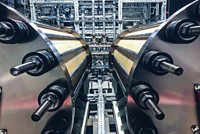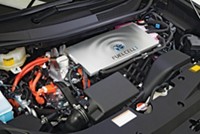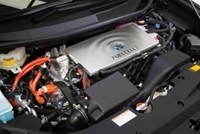Advertisement
Grab your lab coat. Let's get started
Welcome!
Welcome!
Create an account below to get 6 C&EN articles per month, receive newsletters and more - all free.
It seems this is your first time logging in online. Please enter the following information to continue.
As an ACS member you automatically get access to this site. All we need is few more details to create your reading experience.
Not you? Sign in with a different account.
Not you? Sign in with a different account.
ERROR 1
ERROR 1
ERROR 2
ERROR 2
ERROR 2
ERROR 2
ERROR 2
Password and Confirm password must match.
If you have an ACS member number, please enter it here so we can link this account to your membership. (optional)
ERROR 2
ACS values your privacy. By submitting your information, you are gaining access to C&EN and subscribing to our weekly newsletter. We use the information you provide to make your reading experience better, and we will never sell your data to third party members.
Environment
Still Chasing The Hydrogen Economy
Water electrolysis firm aims to help meet 2015 global target for first commercial fuel-cell cars
by Stephen K. Ritter
November 7, 2011
| A version of this story appeared in
Volume 89, Issue 45

In his 2003 State of the Union address, President George W. Bush proclaimed that the time was ripe for the hydrogen economy, a world in which hydrogen is the primary energy currency instead of fossil fuels. He committed $1.2 billion toward research to develop hydrogen fuel-cell technology and the ability to cheaply prepare and store hydrogen to meet transportation needs. Concerns about oil supply, fuel price volatility, and greenhouse gas emissions were going to evaporate.

Proton OnSite’s electrolyzer stacks split water to produce hydrogen for fuel-cell and other applications.
Now, nearly a decade later, a veil of dust has settled over the hype about hydrogen. Officials in the Bush Administration hadn’t promised an overnight success, although the public may have perceived the pronouncements that way. But, as with any disruptive technology, there is a long product development cycle. For hydrogen in particular, the uncertainty over just how long oil will last and competing interests in biofuels and batteries for powering cars stand in the way. Even with these mitigating circumstances, hydrogen technology has moved apace. The original Bush-era goal of rolling out commercial hydrogen fuel-cell cars in 2015 is still on track.
Perhaps no one is as happy about that as Thomas D. Sullivan, a bootstrap entrepreneur who founded Lumber Liquidators, the U.S.-based retailer of hardwood flooring. In 2008, Sullivan transitioned from hardwood to hydrogen when he bought Proton OnSite, a producer of on-site hydrogen generators based on proton exchange membrane water electrolysis. Established in 1996, Proton OnSite has sold thousands of its electrolyzers. So far those devices are mostly being used to make hydrogen for applications other than driving cars. But Sullivan is positioning the company to be ahead of the hydrogen transportation curve by building hydrogen fueling stations as part of a needed national infrastructure.
“There has definitely been a little bit of a hype hangover from when the Bush Administration championed fuel cells and hydrogen,” says Robert J. Friedland, Proton OnSite’s cofounder and chief executive officer. “In reality, the Department of Energy and automakers have always had a plan to look at a combination of hybrid electric, battery electric, and fuel-cell vehicles,” Friedland says. “This plan covers the whole spectrum of transportation alternatives so the public can choose a vehicle based on their needs—from a short commute and trip to the grocery store to interstate travel. But each Administration tends to have its favorites.”
Friedland notes that when the Obama Administration took office, and physicist Steven Chu became secretary of the Department of Energy, there was a noticeable shift in transportation energy strategy. “When Secretary Chu came onboard, his focus was to look at batteries as a technology that could more quickly get to market, and fuel cells in his mind were too far off to make an impact within Obama’s presidency,” Friedland says.
The Obama Administration has cut spending for hydrogen programs, and in published reviews of energy technologies it has touted hybrid and electric cars while putting hydrogen fuel cells on the back burner. President Obama has set a goal of putting 1 million hybrid and fully electric cars on U.S. roadways by 2015. There is no such federal goal for hydrogen fuel-cell cars.
The rest of the world seems to have stayed committed to hydrogen, Friedland points out. For example, Germany has announced it will build 1,000 hydrogen fueling stations by 2020, allowing travel between major cities, he says. But the U.S. is not planning to fund or provide incentives to build any commercial hydrogen stations, Friedland notes. This policy places U.S. leadership in hydrogen and fuel-cell technology in a tenuous position, which Sullivan, Friedland, and their colleagues at Proton OnSite, along with their competitors, hope to alleviate.
Currently only a few hundred hydrogen-powered fuel-cell test cars are being driven in the U.S. “But car companies are marching ahead with their plan to bring fuel-cell vehicles to market,” Friedland says. He expects the initial price to be in the same range as battery electric cars, about double the cost of gasoline-powered cars.
Even so, Friedland acknowledges, “we aren’t going to stop driving gasoline-powered vehicles anytime soon. The full transition to any type of automobile—hybrid, electric, or fuel cell—is going to take decades. If we begin to roll these vehicles out in 2015, it’s going to be 2040 before we turn over a significant portion of what we call the car park.”
If that turnover is to be a reality, hydrogen fuel must be more widely available to drivers. Although electrolysis to make hydrogen is a mature science, and hydrogen fuel cells are approaching efficiencies that make them practical for passenger cars, there is no infrastructure to supply the fuel. Unlike electricity, there’s no hydrogen grid. And unlike gasoline or diesel, there is no ubiquitous network of pipelines, distributors, and filling stations.
That’s where Sullivan comes in. Sullivan started Lumber Liquidators in 1993, when as a building contractor in the Boston suburb of Stoughton, Mass.—with a few failed business attempts already under his belt—he began buying excess lumber that construction companies didn’t need and reselling it. He created a niche market in hardwood flooring and opened a retail store in 1996. It was a humble beginning, Sullivan recalls. The original Lumber Liquidators headquarters had no running water and a portable toilet outside.
Sullivan grew the company and started adding more store locations. Today, the firm has 260 stores and is the leading U.S. retail hardwood-flooring chain. With Lumber Liquidators humming along, Sullivan was itching to try something new.
“I had been thinking about what was going to be the next fuel after gasoline,” Sullivan relates. “I thought it was crazy that we were still pumping oil out of the ground and polluting the environment.” After studying the alternatives, he concluded that hydrogen produced renewably from sunlight and water makes the most sense.
One weekend in July 2008, Sullivan ran across an article in the New York Times “about a guy in New Jersey who had switched his house and car to run on hydrogen fuel cells powered by solar panels.” The article mentioned that Proton Energy Systems, as Proton OnSite was called then, was the company that had made the electrolyzer to convert the water to hydrogen.
“I checked out Proton, and I found out the company was being auctioned off,” Sullivan says. Proton had fallen on troubled times when its parent company, Distributed Energy Systems, filed for bankruptcy for reasons unrelated to the hydrogen market.
The final day of bids for Proton was the next Tuesday, Sullivan remembers. After checking out the company on Monday, “I put in a bid and ended up getting it.”
When it comes to hydrogen as a chemical, more than 90% of current U.S. demand is generated by steam reforming of natural gas or by coal gasification. It is delivered via pipeline or tube trailers and goes to refining petroleum, producing fertilizer, treating metals, and processing food.
Proton OnSite’s core business is designing and building industrial on-site hydrogen generators, Friedland notes. Its main customers include electric utilities, a multi-billion-dollar market where hydrogen is used as a heat-exchange gas to cool the metal windings in electricity generators in power plants. In addition, the company sells electrolyzers to the semiconductor and materials processing industry, glass manufacturers, and fuel-cell labs for testing. Along with Proton OnSite, Maryland-based Teledyne Energy Systems and Canada-based Hydrogenics are the big three in the industrial on-site hydrogen electrolyzer arena, garnering 90% of the global market, Friedland says.
The $10.2 million Proton purchase was a good business deal for Sullivan. Proton had two things going for it, he says. By selling electrolyzers for industrial and military applications, the company wasn’t relying solely on the fuel application. So it had a business to carry itself even if hydrogen fuel doesn’t pan out. And included in the purchase was a new office building appraised for more than the bid price. In the worst case that the company folded, he could still sell the building.
“To me it was a low risk,” Sullivan says. “I was excited about getting into hydrogen and the potential for playing a role in changing the way we build and drive cars.”
For Sullivan, Proton OnSite’s electrolyzers seemed like a good way to establish a network of hydrogen fueling stations conveniently colocated with his Lumber Liquidators stores. Proton OnSite had already been collaborating with national laboratories, car companies, oil companies, and industrial gas suppliers by providing equipment for hydrogen fuel test stations at some two dozen sites in the U.S. Proton also is pursuing opportunities globally, in particular in Germany, Japan, China, and South Korea.
Currently there are more than 50 hydrogen fuel stations scattered across the U.S. that serve the few hundred fuel-cell cars, buses, and forklifts in use. California is home to nearly half the stations and is leading the U.S. with its California Hydrogen Highway Network, part of the state’s bid to encourage adoption of zero-emissions vehicles.
To help get infrastructure development rolling more quickly, Sullivan created SunHydro, a sister company to Proton OnSite that aims to build a network of commercial hydrogen fuel stations using Proton’s electrolyzers. In October of last year, SunHydro opened its first hydrogen station adjacent to Proton’s headquarters in Wallingford, Conn.
The SunHydro station, situated in the parking lot, is powered by 30,000 sq ft of solar panels on the building’s roof, backed up by the power grid. It is used to fuel 10 fuel-cell cars Toyota supplied for Proton employees and others in the area to drive, as well as some local city buses.
“It was the first fueling station in the world where you can swipe your credit card and fill up with hydrogen,” Sullivan is proud to say. “We would like to have more stations at this point, but we need more fuel-cell cars first.”
SunHydro is gearing up to open a second station in Braintree, Mass., just south of Boston, at a Lumber Liquidators store. The company plans to put stations at other stores in the Northeast and another cluster at stores in the Los Angeles area. Sullivan’s vision is to eventually build hydrogen corridors that would make it possible to drive a fuel-cell vehicle from Miami to Maine and from the East Coast to the West Coast.
Sullivan says he is being honest when he states that his hydrogen fuel venture “is definitely not going to be a moneymaker anytime soon. Ideally, we will have 10 stations in the Northeast and 10 in the L.A. area by 2015. We’ll see what will happen from there.”
To make hydrogen, Proton OnSite’s electrolyzers use platinum-group metal/metal-oxide nanoparticle catalysts deposited on the electrodes, notes Katherine E. Ayers, the company’s director of research. At the anode, water is split into protons, electrons, and oxygen, she explains. The protons migrate through the company’s customized 0.2-mm-thick ionic sulfonated fluoropolymer membranes to the cathode; its competitors Teledyne and Hydrogenics use alkaline liquid electrolyte systems, Ayers says. Meanwhile, electrons travel through an external circuit to reach the cathode. There, the protons and electrons form hydrogen. The catalysts help reduce the voltage required to drive the electrochemical reactions.
Running a fuel cell is electrolysis in reverse: Hydrogen is split into protons and electrons, the electrons flow through the external circuit to create current that is harnessed to produce electricity, and the protons combine with oxygen to form water.
The electrochemical stacks at the heart of the electrolyzers are a collection of individual cells designed so that the hydrogen, dried of its residual water to 99.999% purity, can be recovered under high pressure, Ayers says. Generating hydrogen at high pressure eliminates the need for an external mechanical compressor for most applications and reduces cost, she notes. The electrolyzers can be run by plugging into the power grid, or they can be powered directly by solar cells or wind turbines.
“Hydrogen production and its use in a fuel cell is an elegant cycle, from water to hydrogen and oxygen and then back to water,” Ayers says. “There’s a lot of interesting chemistry and materials involved.”
Advertisement
Companies in the alternative energy business such as Proton OnSite rely on a productive relationship with federal funding agencies and the military, Ayers says. “We work with the government in several ways—for example, through grants from the Small Business Innovation Research program.”
These projects typically involve joint demonstrations in which Proton supplies and sets up hydrogen generators and leaves other aspects of the project to its partners, such as catalyst development and preparing specialty materials to increase hydrogen storage tank capacity, she says.
In conjunction with equipment makers such as Proton OnSite, DOE and automakers have set technical and economic targets for 2015, most of which have been met or are getting close, Ayers says. For example, fuel-cell cars need to store enough hydrogen, at least 6 kg, to match the 300-mile or more per tank driving range of gasoline-powered cars. The energy in 1 kg of hydrogen translates to about 2.5 gal of gasoline in terms of miles traveled, she says. Fuel-cell cars currently on the road average the equivalent of 40 to 60 mpg, according to National Renewable Energy Laboratory data.
The ability to store enough hydrogen onboard to meet the mileage target was an early concern for hydrogen fuel-cell cars. But most automakers use steel or carbon composite tanks that are filled to 10,000 psi, with a size and weight that are now becoming comparable to gasoline tanks on cars. Another concern, and one of the most important targets, is to reduce hydrogen production cost to be competitive with gasoline. SunHydro’s untaxed hydrogen goes for the equivalent of about $4.00 per gal of gasoline, a price that still needs to come down to about $3.00.
“We have reliable electrolyzer systems, so now our research is mostly on materials and scale-up to reach new milestones in efficiency and reducing cost,” Ayers explains. “We are interested in alternative catalysts and reducing the amount of precious-metal catalysts we use.”
Although it’s expensive, both for electrolysis and for fuel cells, the catalyst is only about 6% of the cost of a unit, Ayers notes. Catalyst cost and availability only become factors for scaling up to make many units, such as for fuel stations, she says. New nanostructured electrode materials developed by 3M scientists, and being tested by Ayers and her team, increase surface area and catalytic activity. These designs reduce the amount of catalyst needed by an order of magnitude, she says, bringing the amount of precious metals used close to that in a car’s catalytic converter. Proton also interacts with academic and national lab researchers who are developing photocatalysts that directly absorb light and split water, she says. But developing commercial devices with these catalysts is perhaps 20 years away, she notes.
Proton OnSite is also collaborating with others to improve polymer electrolyte membranes. For example, the company has a project with polymer chemist Michael A. Hickner at Pennsylvania State University in which his group is coming up with hydrocarbon-based ionic polymers for thinner and less expensive membranes, Ayers says.
According to cleantech market analyst firm Pike Research, some 5,200 hydrogen fueling stations to service light-duty vehicles, forklifts, and buses are expected worldwide by 2020, up from about 200 today. Pike analysts anticipate there will be about 1 million fuel-cell vehicles globally by that time for economic reasons—half the number expected in a previous forecast. They note that companies like Proton OnSite and SunHydro will play a role by providing a modular pathway to hydrogen infrastructure.
But as Friedland and others in the industry believe, oil companies will wring out as much as they can from fossil fuels first. Then as hydrogen and biofuels become more prevalent, companies that already operate gasoline stations and large industrial gas companies will use their clout to take control of the new fuel markets.
Fuel-cell cars are “great to drive,” Sullivan says, and he believes “they will appeal to Americans because you can get a regular-sized car or SUV and be pollution-free. As a country, I think the U.S. should support development of alternative fuels, whether it’s hydrogen or something else. We should be the leader and export this technology, rather than import oil.”





Join the conversation
Contact the reporter
Submit a Letter to the Editor for publication
Engage with us on Twitter